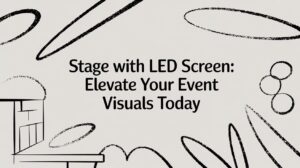
Stage with led screen: Elevate Your Event Visuals Today
Not long ago, a stage with an led screen was just a fancy backdrop. Now, it's the dynamic, beating heart of any modern live event.
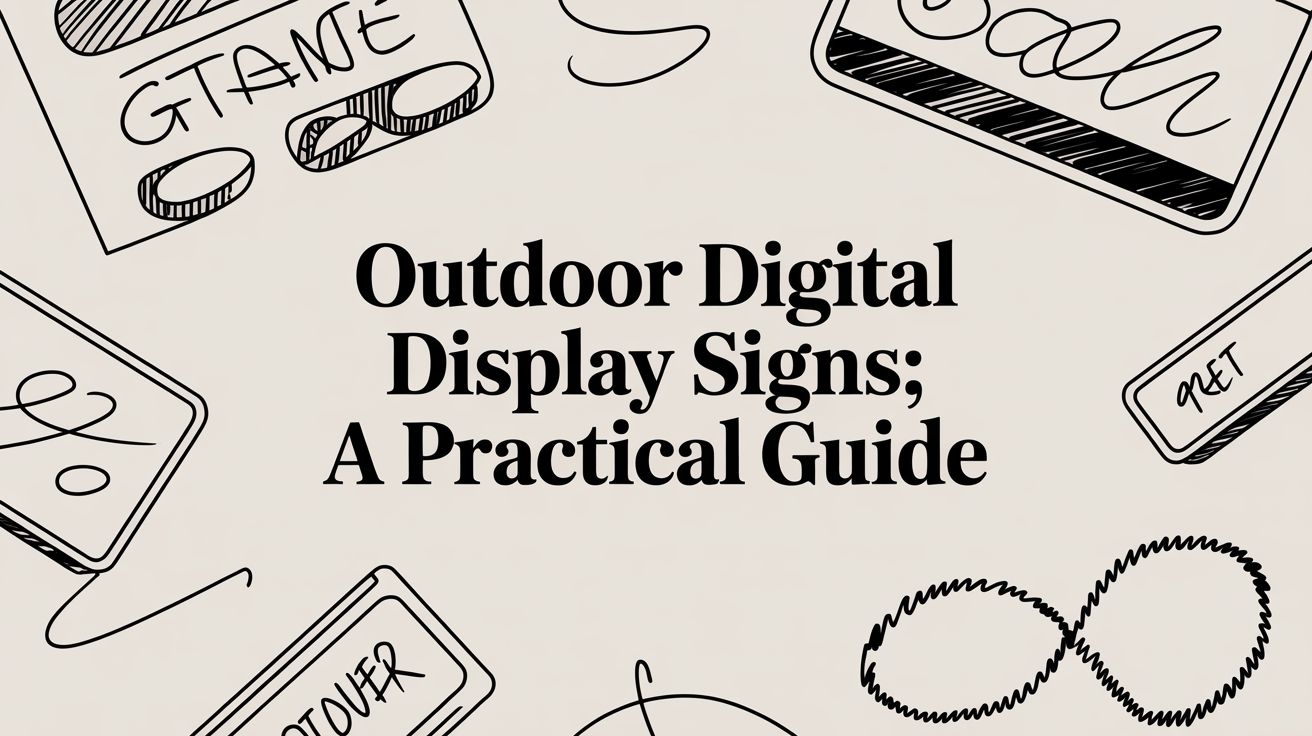
Think about the last time a static, printed billboard truly caught your eye. It’s tough, right? For decades, that was the best we could do—a single, unchanging message trying to grab the attention of thousands of drivers, shoppers, and pedestrians.
Today, that old playbook is obsolete. Outdoor digital display signs have completely changed the game, giving businesses and cities a dynamic, responsive, and frankly, more exciting way to communicate.
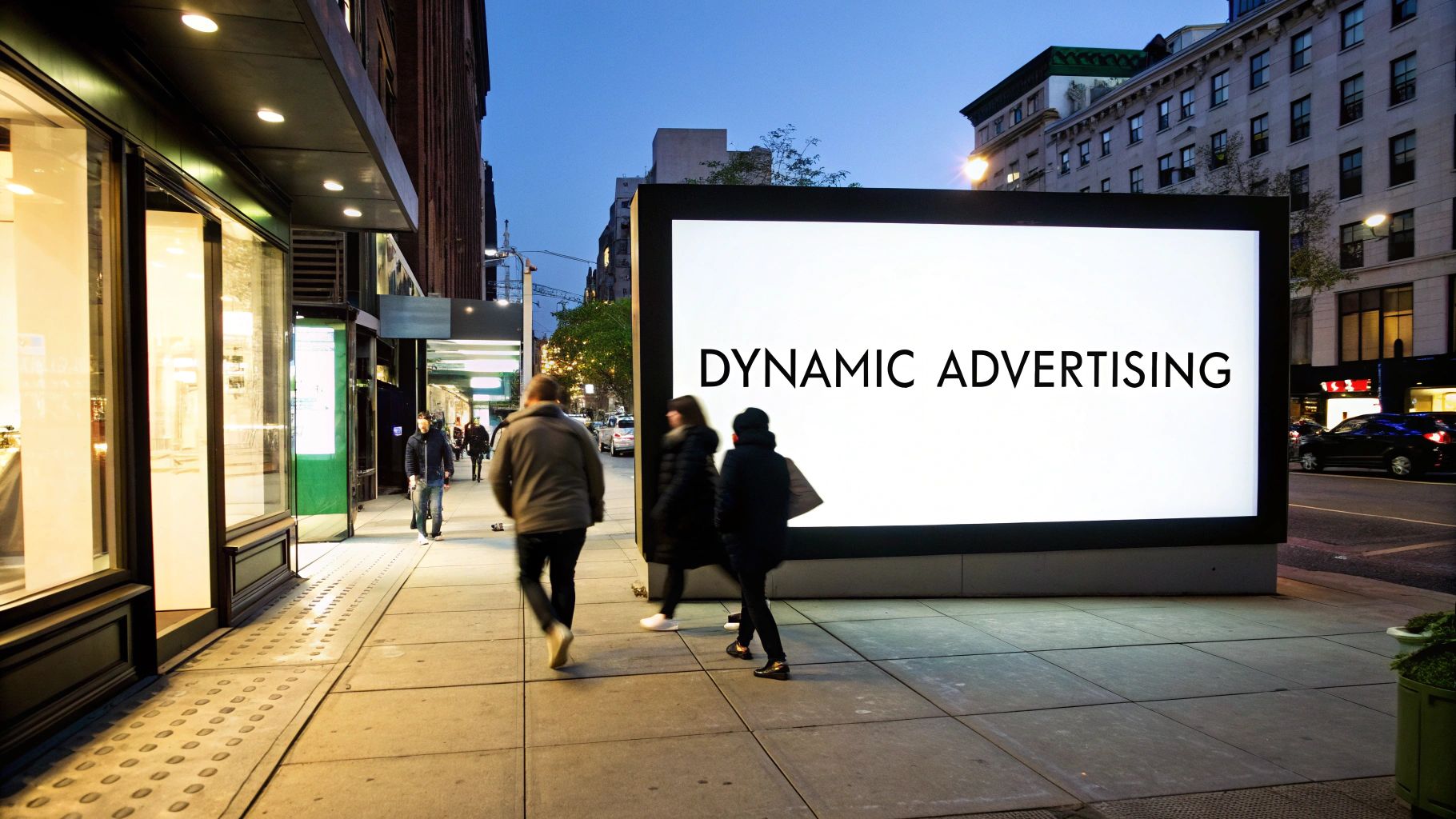
Instead of a lifeless poster, you now have a vibrant screen that can show full-motion video, switch up promotions in a heartbeat, or even react to things like the weather. This isn't just a simple tech upgrade; it's a fundamental shift in how organizations can engage with people out in the real world.
This guide isn't here to give you sterile definitions. We're diving deep into what makes this technology so essential, showing you not just what these signs are, but how to choose the right one, get it installed, and manage it for maximum impact.
Make no mistake, the move to digital signage isn't a passing fad. It's a massive market shift driven by the demand for more effective ways to connect with audiences. The global market hit $40.3 billion in 2023 and is on track to soar to $55.7 billion by 2032.
This isn't just growth; it's a clear signal that businesses and cities are seeing real value here. If you want to dig into the numbers yourself, check out these outdoor digital signage market trends.
An outdoor digital sign is no longer just an advertising tool; it's a communications hub. It can serve as a landmark, a public information system, and a powerful driver of local commerce all at once.
No matter what industry you're in, these displays offer some serious advantages over their static, old-school cousins. By the time you finish this guide, you'll know exactly how they can help you hit your own goals, whether that's boosting sales or creating unforgettable community events.
Here are the key wins:
Not all outdoor digital signs are created equal. Just like a contractor wouldn't use the same tool for every single job, the right digital sign depends entirely on your mission. Getting this first step right ensures your investment lines up perfectly with your timeline, budget, and what you’re trying to achieve.
Think of these categories as different tools in a toolbox, each designed for a specific purpose. Some are built for permanence, becoming landmarks in their own right. Others are made for mobility and short-term impact. Understanding these differences is the first step toward making a smart, effective choice.
When you picture a digital sign that becomes part of a building's identity, you're thinking of a permanent display. These are the absolute workhorses of the industry, engineered for the long haul and built for continuous, 24/7 operation. They are physically anchored to a location—becoming a consistent, reliable touchpoint for your brand.
A perfect example is the big pylon sign at a shopping center entrance or the monument sign outside a corporate headquarters. These aren't temporary fixes; they're architectural elements designed to last for years, delivering daily information, ads, and branding. Because they’re built to endure whatever the weather throws at them, these signs often feature fully sealed components, like those in our Outdoor Elite Series, to lock out moisture and ensure they keep running for years.
A permanent digital display is an investment in presence. It signals stability and becomes a constant, dynamic voice for your location, communicating with the community day and night.
These installations are the go-to for any business that wants to establish a landmark presence and has a steady flow of traffic to engage.
While they are also permanent, digital billboards really sit in their own category. It all comes down to their sheer scale and primary function: high-impact advertising. These are the massive screens you see looming over highways and lighting up major city centers, grabbing the attention of thousands of drivers and pedestrians every day.
Their business model is completely different from a sign for a single business. Billboard operators lease out advertising slots to multiple companies, rotating the content every few seconds. This demands seriously robust software for scheduling and management, not to mention exceptionally bright displays that can cut through direct sunlight and be seen from long distances at high speeds. The focus here is all about maximum reach and rapid-fire message delivery to an audience that’s always on the move.
But what if your need isn't permanent? For one-off events like concerts, festivals, trade shows, or even a weekend sporting tournament, mobile and rental displays are the perfect answer. These signs are often built right onto trailers or trucks, which means they can be driven directly to a location and be up and running in minutes.
They offer incredible flexibility for short-term projects, ready to display anything from live video feeds to sponsor ads and event schedules. The key advantage is portability. You get the huge impact of a digital sign exactly where you need it, for precisely how long you need it, without the commitment and cost of a permanent installation.
Finding the middle ground between a quick rental and a permanent fixture are the semi-permanent solutions. These are designed for projects that might last several months or even a year but aren't intended to stick around forever.
Think about a major construction project. A semi-permanent digital sign can show project updates, safety information, and ads for future tenants for the entire duration of the build. Another common use is for seasonal promotions, like a huge holiday-themed display at a retail center that gets taken down after the season ends. They give you more durability than a rental but can still be relocated once the campaign or project is over.
To make it even clearer, this table breaks down the primary types of outdoor digital displays so you can quickly identify the best fit for your specific goals.
| Display Type | Primary Use Case | Installation Type | Best For |
|---|---|---|---|
| Permanent Fixed | On-premise branding, information, and advertising | Anchored to a specific location (pylon, monument, facade) | Businesses establishing a long-term physical presence (retail, corporate, schools). |
| Digital Billboard | Third-party advertising | Large-scale, permanent structures along high-traffic routes | Media companies and advertisers wanting to reach a massive, transient audience. |
| Mobile & Rental | Short-term events, promotions, and live feeds | Mounted on trailers or portable structures for easy setup | Concerts, festivals, trade shows, and temporary marketing campaigns. |
| Semi-Permanent | Medium-term projects and seasonal campaigns | Installed for months to a year, then relocated or removed | Construction sites, seasonal retail promotions, and extended marketing events. |
Each type serves a distinct purpose. By matching the display type to your objective, you ensure your message not only gets seen but makes the right kind of impact.
Jumping into the technical details of an outdoor digital display can feel like trying to learn a new language. You’ll hear terms like pixel pitch, nits, and IP ratings tossed around, but what do they actually mean for how your sign will look and perform? Getting these specs right is the difference between a sign that dazzles and one that just disappears.
Think of it like buying a car. You wouldn't make a decision without knowing its horsepower or fuel efficiency. In the same way, understanding these core metrics ensures you invest in a display that looks brilliant day after day, works reliably, and ultimately delivers a powerful return on your investment.
Let's break down the most important numbers in simple, practical terms.
Pixel pitch is probably one of the most critical factors that dictates your sign's clarity. It’s simply the distance, measured in millimeters, from the center of one tiny LED pixel to the center of the next. The smaller the pixel pitch number, the closer the LEDs are packed together, which gives you a higher resolution and a much sharper image.
It’s a lot like the dots in a newspaper photo. From far away, they all blend together to create a clear picture. But if you get right up close, you can see the individual dots, and the image looks grainy. The same idea applies to outdoor digital display signs.
Key Takeaway: The perfect pixel pitch really depends on how far away people will be when they see it. For a massive sign on a highway viewed from hundreds of feet away, a larger pitch (like P10 or P16) is perfectly fine. But for a storefront sign that people will walk right past, you need a smaller pitch (like P4 or P6) to get that crisp, seamless look.
Getting this right is everything. It ensures your content looks professional and gives viewers a great experience.
An outdoor sign has one major competitor it has to beat every single day: the sun. This is where brightness, measured in a unit called nits, becomes absolutely non-negotiable. A higher nit rating means a brighter screen that stays vibrant and readable even in direct, blinding sunlight.
To put it in perspective, your indoor TV probably has a brightness of around 300-500 nits. That’s great for the living room, but it would be completely washed out the second you took it outside.
This spec is a make-or-break deal. Underestimating your brightness needs is one of the most common—and most expensive—mistakes a new buyer can make.
The infographic below shows how different types of outdoor signs are deployed, each with its own set of technical requirements tailored to its specific job and environment.
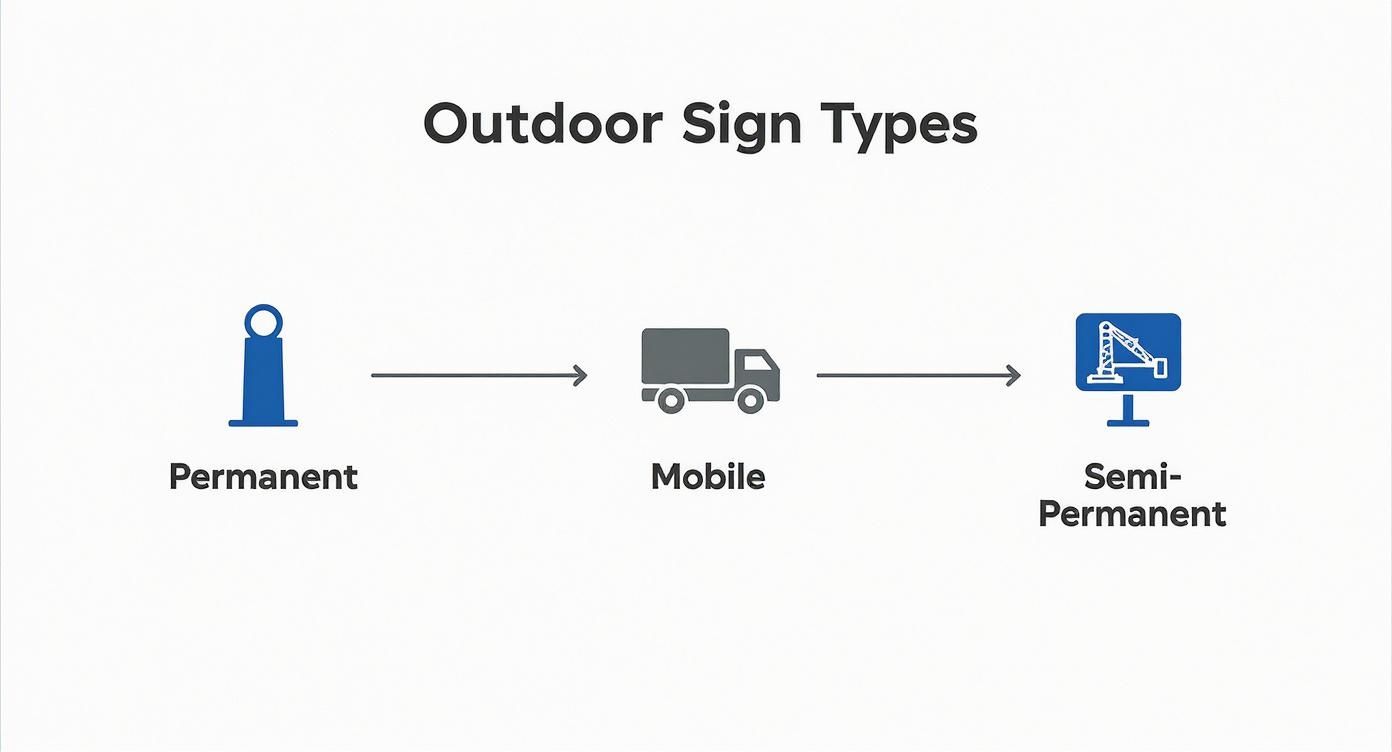
This flow gives you a good idea of how permanent, mobile, and semi-permanent displays are chosen based on the goals and timeline of a project.
An IP rating, which stands for Ingress Protection, is basically your sign's weather-resistance score. It's a simple two-digit number that tells you exactly how well the sign's casing is sealed against solid things (like dust) and liquids (like rain).
For any outdoor sign, you should be looking for a rating of IP65 or higher. This guarantees it’s built to withstand dust, driving rain, snow, and whatever else Mother Nature decides to throw at it, protecting your investment for years to come. This kind of durability is a huge reason the outdoor signage market is booming. The global digital signage market was valued at $28.83 billion in 2024 and is projected to hit $45.94 billion by 2030, with outdoor displays leading that charge.
While pixel pitch, brightness, and IP rating are the big three, a few other specs play a crucial role in creating a high-quality display.
The Contrast Ratio is the difference between the brightest white and the darkest black a screen can create. A high contrast ratio makes your colors pop and ensures text is sharp and easy to read from a distance.
The Refresh Rate, measured in Hertz (Hz), tells you how many times per second the screen redraws the image. A higher refresh rate (think 1920Hz or more) is essential for smooth, flicker-free video. It’s also important if people will be taking pictures or videos of your sign with their phones—a low refresh rate will show up as ugly black bands on their screen.
Understanding these specifications will empower you to ask the right questions and confidently choose from the many LED signs for businesses to find one that perfectly fits your needs.
You can have the most incredible outdoor digital sign in the world, but if you stick it in the wrong spot, it's like shouting into an empty room. It's a wasted effort and a squandered investment. The success of your sign hinges just as much on where it is and how it’s installed as it does on its fancy tech specs. This is the foundational work that ensures your message actually reaches people.
Think of this phase as your project's blueprint. It’s about doing the homework—a meticulous site survey, understanding the real-world structural needs, and a clear-eyed look at the logistics of power, data, and local laws. Getting this right from the jump prevents nasty, expensive surprises later and sets your sign up for years of powerful performance.
Before a single bolt is turned, a thorough site survey is an absolute must. This isn't just about picking a spot that "looks good." It's a data-driven process to find the sweet spot for maximum visibility and engagement. Put on your detective hat and start gathering clues about the environment to solve the puzzle of perfect placement.
Here's what you need to investigate:
A well-executed site survey does more than just find a location; it defines the technical requirements of the sign itself. Discovering that a spot gets eight hours of direct afternoon sun tells you a standard-brightness display won't cut it—you need a high-nit model, period.
Once you've zeroed in on the perfect spot, you need to figure out how you're going to mount your outdoor digital display sign. The structure is more than just a stand; it's a critical part of the sign's safety, stability, and overall look.
A digital sign is just a very expensive piece of metal without reliable power and a data connection. These can't be an afterthought. They need to be planned and often installed before the sign structure even shows up. You'll need a licensed electrician to run a dedicated power line to the site that meets the sign's specific voltage and amperage needs.
For connectivity, a hardwired ethernet cable is king—it offers the most stable and secure performance for updating your content. If digging a trench for a cable just isn't in the cards, a robust cellular or high-quality Wi-Fi connection can work, too. When planning this stage, it’s smart to explore different outdoor technology solutions to make sure your sign always has a rock-solid connection.
Finally, every single installation has to play by the local rules. Honestly, navigating permits and zoning can be one of the most frustrating parts of the whole process. Most cities and counties have strict regulations about sign size, height, brightness, and even how often the message on the screen can change.
Start this process early. Your first call should be to your local planning or building department. If you fail to get the right permits, you could be looking at heavy fines or even an order to tear the whole thing down. This is where a professional signage partner becomes invaluable; they’ve been through this maze before, know the local codes, and can handle the entire permitting process for you.
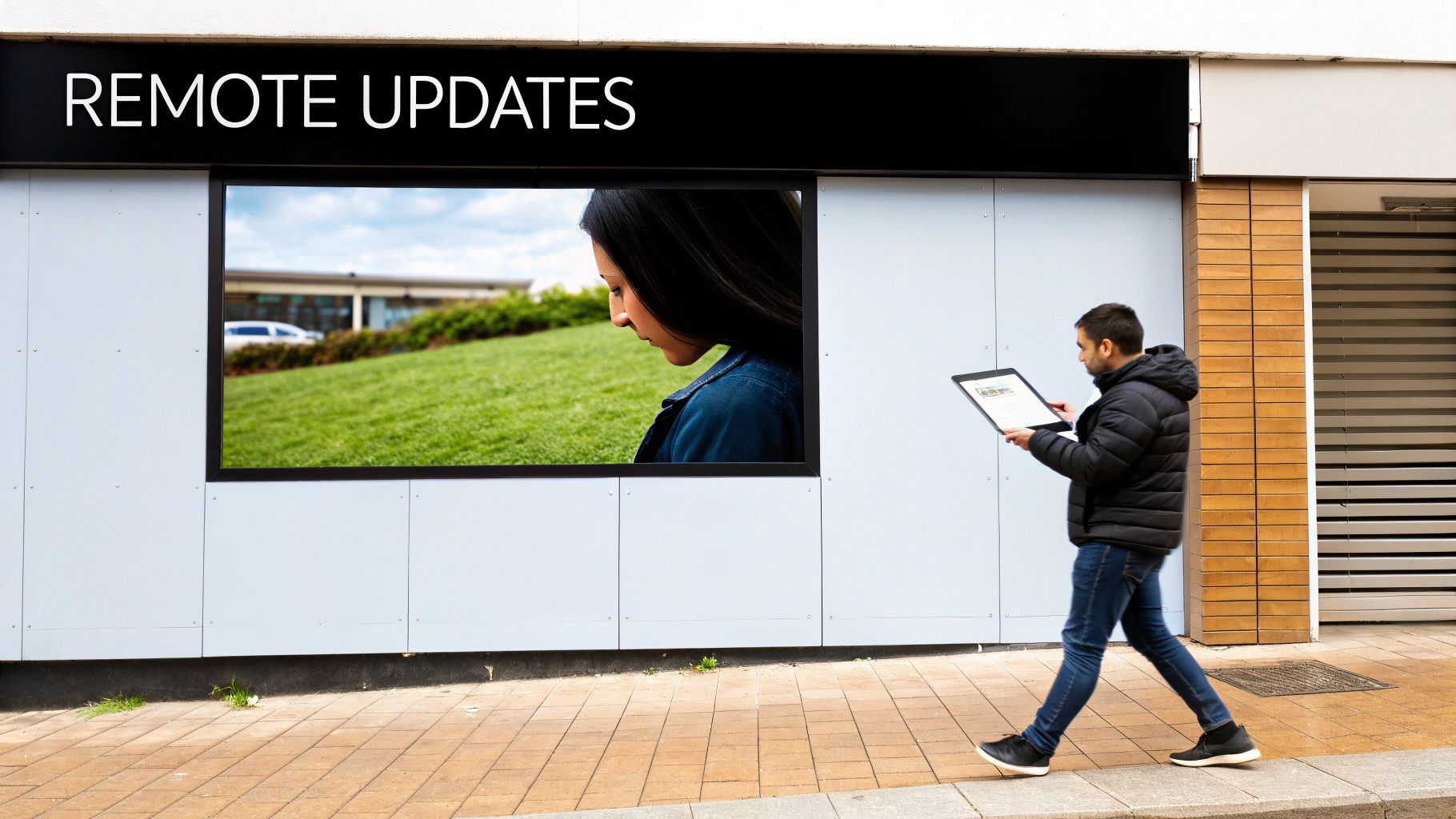
Your outdoor digital display is a powerful stage, but let’s be honest: the content is the undisputed star of the show. A stunning, high-resolution screen with a weak, boring message is just a massive missed opportunity. To truly connect with your audience and make an impact, you need the right tools to create, schedule, and launch your content with precision and—most importantly—ease. This is where the behind-the-scenes software becomes your most valuable asset.
Think of it this way: your digital sign is the body, but the software is its brain. The media player is the device that physically stores and runs your videos and images, while the Content Management System (CMS) is the command center where you call all the shots. Together, they bring your screen to life, turning it from a static object into a dynamic, revenue-generating machine.
A modern CMS puts you in complete control of your sign from anywhere with an internet connection. Gone are the days of fumbling with a USB drive, climbing a ladder, and manually plugging it into the sign. Today’s systems are cloud-based, offering a level of flexibility that was once unimaginable.
With just a few clicks from your laptop or tablet, you can:
The real magic of an effective CMS is its ability to deliver the right message, to the right audience, at the perfect time. It’s not just about showing an ad; it’s about creating a relevant, timely experience for the viewer that feels personal.
The most advanced systems take things even further by plugging into live data feeds. This allows your sign to react to the world around it automatically, creating highly relevant and eye-catching content without you having to lift a finger.
Imagine the possibilities:
This dynamic capability is a huge reason why businesses and advertisers are flocking to digital. The sheer versatility and superior content management of outdoor digital display signs make them an essential tool for grabbing attention in retail centers, public squares, and transit hubs. You can discover more about the rapid growth of the signage market and its applications here.
Here’s a critical piece of advice: creating content for an outdoor screen is a completely different ballgame than designing for print or a website. You have just a few seconds to grab the attention of people who are walking, driving, and often distracted. Clarity and impact are everything.
Stick to these proven design principles:
By combining powerful management software with smart, punchy design, your sign becomes more than just a display—it becomes a strategic asset that gets people talking and drives real results.
When you're thinking about investing in an outdoor digital display, it's easy to focus on the price tag of the sign itself. But that's only the beginning of the story. To make a truly smart financial decision, you need to look at the complete picture—the Total Cost of Ownership (TCO) and, even more importantly, the Return on Investment (ROI) it’s going to generate for your business.
Thinking only about the screen's cost is like buying a car and forgetting about insurance, gas, and oil changes. TCO covers everything from the sign itself to installation, permits, software, and even energy costs down the road. Getting a handle on these numbers from the start gives you a transparent view of the full financial commitment.
The initial purchase is just one piece of the puzzle. To budget accurately, you have to account for several other essential expenses that make up the total cost.
Here’s a quick breakdown of what to expect:
For a much deeper dive into these factors, our guide on outdoor LED sign costs breaks it all down to help you plan your budget with confidence.
Calculating the Total Cost of Ownership isn't about getting lost in a spreadsheet; it's about making an informed investment. A clear understanding of all costs prevents surprises and helps you build a much stronger business case from day one.
Once you have a grip on the costs, you get to the exciting part: calculating the return. Outdoor digital signs aren't just expenses; they are powerful, revenue-generating tools. Their value shows up in both direct profits and indirect benefits that boost your bottom line over time.
Think of ROI in two key categories: hard returns and soft returns.
This is the stuff you can easily count. A digital sign can directly drive sales by promoting specific products or flash sales, pulling in immediate foot traffic. In fact, studies have shown that businesses often see a sales lift of 15% to 150% after installing a digital sign. You can also generate a whole new revenue stream by selling advertising space to other local businesses, turning your sign into a consistent moneymaker.
These benefits are just as valuable, though a little trickier to nail down with a simple dollar figure. A vibrant, dynamic digital sign dramatically enhances how people see your brand, making your business look modern, professional, and successful. It also boosts customer engagement by sharing useful info, like event schedules or community announcements. This brand lift and improved community presence build long-term loyalty and recognition that pay off for years to come.
Making a big investment like an outdoor digital sign naturally comes with a lot of questions. That’s a good thing. Getting clear, straightforward answers is how you move forward with confidence, making sure you understand not just the tech but the real-world ins and outs of owning and running one.
We’ve put together answers to the questions we hear most often from buyers. This isn’t a list of dry, technical specs; it’s the practical stuff you actually need to know to make a smart decision and know what to expect from your new digital workhorse. Let’s get into it.
This is usually the first question people ask, and for good reason. An outdoor digital display sign is a long-term play, and you need to know it’s built to go the distance. A high-quality, professionally built sign is engineered for a seriously long life, with most rated for an impressive 100,000 hours of operation.
So, what does that number mean in reality? It translates to over 11 years of non-stop, 24/7 use. Of course, a few things will influence that lifespan. The quality of the LED diodes themselves, how well the sign gets rid of heat, and its ability to stand up to your local weather are all huge factors.
Good maintenance habits—which we’ll get to next—are also key to hitting that 100,000-hour mark and maybe even blowing past it. A sign with a solid IP rating and top-notch weatherproofing is always going to outlast a cheaper model when the years start to add up.
Here’s the good news: modern outdoor digital signs are designed to be incredibly low-maintenance. The days of constant tinkering and service calls are pretty much over. But "low-maintenance" isn't the same as "no-maintenance." A few simple, periodic tasks will keep your sign looking sharp and protect your investment for the long haul.
It really boils down to a few key tasks:
Many of today’s systems also have remote diagnostic software built right in. This lets you or your service provider keep an eye on the sign's health from anywhere, often flagging potential issues before you’d ever notice them on screen.
"Think of sign maintenance like the regular oil changes for your car. They are simple, proactive steps that prevent major, costly breakdowns and ensure your asset delivers reliable performance for years on end."
Yes, absolutely. This is one of the most powerful things you can do with a modern outdoor digital display sign. Most of the signs you see today are more than capable of handling smooth, full-motion video, streaming content, and even showing live TV feeds if that’s what you need.
It all comes down to the media player and the Content Management System (CMS) software you’re using. To make sure your video looks flawless, you’ll want to pay attention to two specs. First, a high refresh rate is a must to avoid any flicker or motion blur. Second, you’ll need a solid, high-speed internet connection—wired or wireless—to feed that video stream to the sign without any hiccups.
Let’s be clear: a commercial-grade outdoor digital sign isn’t your living room TV. These are rugged machines, specifically built to not just survive but thrive in harsh conditions. They’re designed to handle everything from blistering summer heat and direct sun to freezing cold, snow, and ice.
The spec you want to look for here is the IP (Ingress Protection) rating. A rating of IP65, for instance, tells you the sign's cabinet is completely sealed against dust and can handle powerful jets of water from any direction. That’s more than enough for a heavy downpour. These signs are also built with tough materials that resist impacts from hail and wind-blown debris, making sure your message shines through, no matter what Mother Nature throws at it.
Ready to bring your vision to life with a high-impact outdoor display? The team at Smart LED Inc. offers factory-direct pricing on industry-leading signs, backed by expert guidance from design to installation. Explore our solutions and see how we can help your business stand out.
Learn more about our outdoor LED signs and get a quote today!

Not long ago, a stage with an led screen was just a fancy backdrop. Now, it's the dynamic, beating heart of any modern live event.

Forget massive stadium jumbotrons for a moment. When we talk about a small LED display, we’re not necessarily talking about its physical dimensions. Instead, we’re

LED screens on stage aren't just backdrops anymore—they're the pulsing, dynamic heart of today's live events. These huge digital canvases are designed to be insanely
"*" indicates required fields